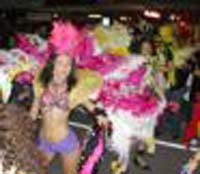Brazil's carnival: all the people, all the movement
Fireworks explode over the packed parade stadium, samba drums erupt and thousands of dancers tap their heels to the propulsive Carnival rhythms. But something is missing. Where are the giant floats, the elaborately plumed costumes, the sequined micro-kinis of Brazil's biggest bash?

This is not Carnival but merely an open rehearsal before Rio de Janeiro's four-day, pre-Lenten festival opens Feb. 25, although a casual observer could easily mistake it for the real thing. "It's amazing: all the people, all the movement," said Haya Azner, a 22-year-old student from Israel.
Every weekend since December, the technical rehearsals by the city's 14 premiere samba groups, known here as schools, have attracted crowds eager for a taste of Carnival. The rehearsals have brought added life to the 766 yard-long (700-meter-long) Oscar Niemeyer-designed Sambadrome stadium, which plays host to the parade but remains dark most of the year.
For Azner, it's a chance to experience Rio's carnival before she leaves for other destinations, she plans to spend carnival in the northeastern seaside city of Olinda. Others, like Mizete Canuso, go to sample a spectacle they otherwise couldn't afford. The cheapest seats with a full view of the parade cost US$50 ( Ђ 42), about a third of Brazil's monthly minimum wage.
"I'm here because I love samba," said Canuso, a 53-year-old housewife. "Also, I can't afford tickets for the actual parade." While the carnival parade might seem like an over-the-top, anything-goes celebration of feathers and bare flesh, it's actually a tightly choreographed spectacle involving thousands of dancers, musicians and technicians who spend months preparing.
That hasn't always been easy. Until recently, the samba schools were forced to rehearse in crowded warehouses and on city streets. "Parading was like throwing everything up in the air and waiting to see what was going to happen," said Max Lopes, the carnival designer for the Mangueira samba school, one of the city's most famous.
But three years ago, the Independent League of Samba Schools, which organizes the two-day parade, decided to let each school hold three rehearsals inside the Sambadrome.
"It certainly improved the show," said Ailton Guimares Junior, the league's president. "It gives the schools a chance to perfect their parades and take out the flaws. This is the actual stage, very different from the street."
The atmosphere at the rehearsals is more relaxed than at the parade. But the schools take the competition seriously, spending about US$2 million ( Ђ 1.6 million) each on the parade and the tension is palpable even during practices, reports the AP.
N.U.
Subscribe to Pravda.Ru Telegram channel, Facebook, RSS!


